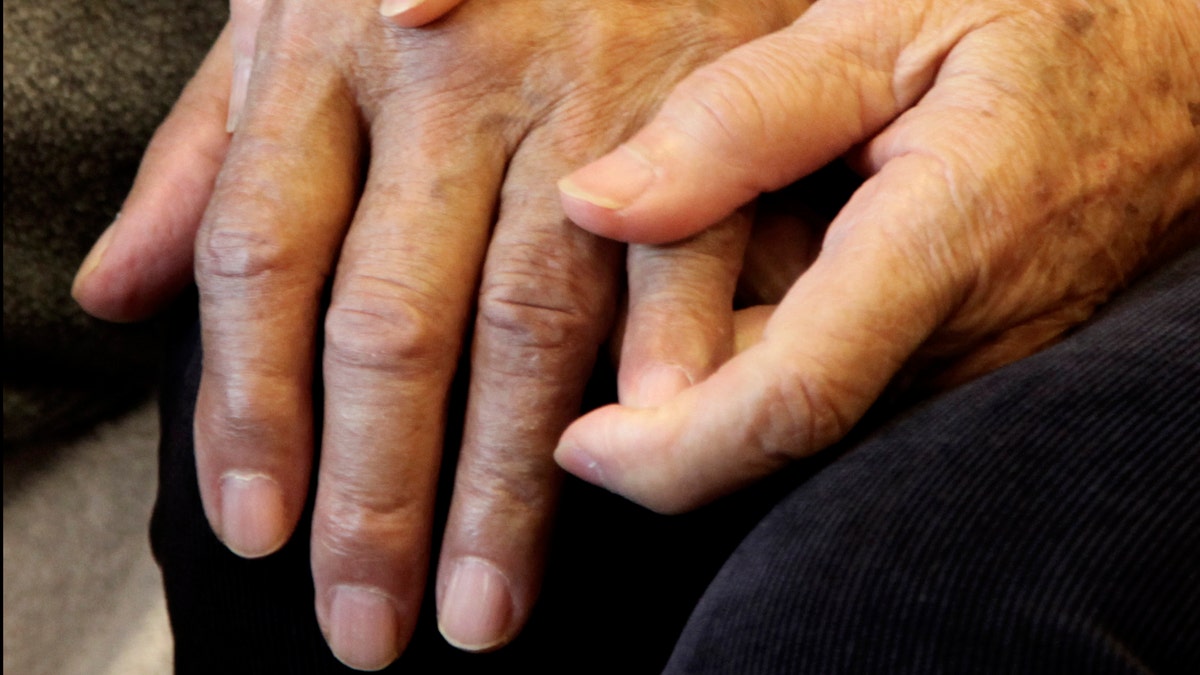
Shou-Mei Li holds the hand of her husband Hsien-Wen Li, who is an Alzheimer's patient, at their home in San Francisco, in this photo taken, Thursday, Sept. 1, 2011. Dementia is poised to become a defining disease of a rapidly aging population _ and a budget-busting one for Medicare, Medicaid and families. The Obama administration is developing the first national Alzheimer's plan to combine research aimed at fighting dementia with help for caregivers. Around the country, thousands of families are pleading for changes to improve early diagnosis and help keep loved ones at home instead of in nursing homes. (AP Photo/Ben Margot) (AP)
Criminal behavior in older adults, including theft, traffic violations, sexual advances, trespassing, and public urination, may be a sign of dementia, researchers say.
There is a subgroup of people, especially older adults who are first-time offenders, who may have a degenerative brain disease underlying their criminal behavior, said Dr. Georges Naasan of the Memory and Aging Center and Department of Neurology at the University of California, San Francisco.
He and his coauthors reviewed the medical records of 2,397 patients diagnosed with Alzheimer’s disease or other types of dementia between 1999 and 2012. They scanned patient notes for entries about criminal behavior using keywords like ‘arrest,’ ‘DUI,’ ‘shoplift’ and ‘violence’ and uncovered 204 patients, or 8.5 percent, who qualified.
Their behaviors were more often an early sign of frontotemporal dementia (bvFTD) or primary progressive aphasia (PPA), a type of language-deteriorating dementia, than of Alzheimer’s disease.
Of the ‘criminal’ group, 64 had bvFTD, 24 had PPA, 42 had Alzheimer’s, and the rest had various other forms of dementia.
Patients with bvFTD or PPA tended to be younger, averaging 59 to 63 years old, compared to Alzheimer’s patients, who were an average age of 71, when their doctors made notes about criminal behaviors.
More than 6.4 percent of those in the “criminal group” with bvFTD exhibited physical or verbal violence during their illness, compared to 3.4 percent of those with PPA and two percent of those with Alzheimer’s disease, the researchers reported in JAMA Neurology.
For four percent of patients with bvFTD, violence was one of the first symptoms of their brain disease.
Men were considerably more likely than women to make sexual advances to others and to urinate in public.
If patients have a family history of the neurodegenerative disease, it may be possible to connect new criminal behavior to an underlying problem with the brain, Naasan said.
“However, most of these diseases are 'sporadic' meaning that they occur for no identifiable genetic cause and it is difficult to predict,” he said. “In general, an early detection of changes in personality, deviation from what constituted a ‘norm’ for a particular individual, should prompt an evaluation for possible brain causes.”
Early signs of bvFTD can include personality changes including disinhibition, lack of empathy, loss of motivation or apathy, or obsessive-compulsive behavior, he said.
“It is sometimes hard to wrap our minds around the concept that a specific part of our brain is not functioning properly, leading to behaviors that may range the gamut of disruptive, detached and sometimes criminal,” Naasan said.
Family and friends can easily take these behavior changes personally, but they should understand that it may be the first sign of a disease and should request a medical evaluation, he said.
“The amoral conduct seen in FTD spectrum disorders strikes the examiner as patient’s deliberate choice, these individuals seem selfish and temperamental with little regard for their worried and frustrated family members,” said Dr. Adonis Sfera, staff psychiatrist at Patton State Hospital in Orange County, California, who was not part of the new research.
“As their behavior looks like mental illness, some of these people end up admitted in psychiatric hospitals, while others are imprisoned or placed in state psychiatric hospitals after being diagnosed with antisocial personality disorder,” Sfera told Reuters Health by email.
It’s difficult to say how much crime may be due to these types of causes, Naasan told Reuters Health by email.
He and his colleagues did not survey criminal records and so they can’t say what percentage of all people who commit crimes have neurological disorders.
Health care providers are not usually familiar with FTD, and frequently misdiagnose it as bipolar disorder or late onset schizophrenia, he added.
FTD spectrum disorders can be accurately diagnosed with so-called PET scans (positron emission tomography) and neuropsychological testing, “but only if we think of it,” Naasan said.
